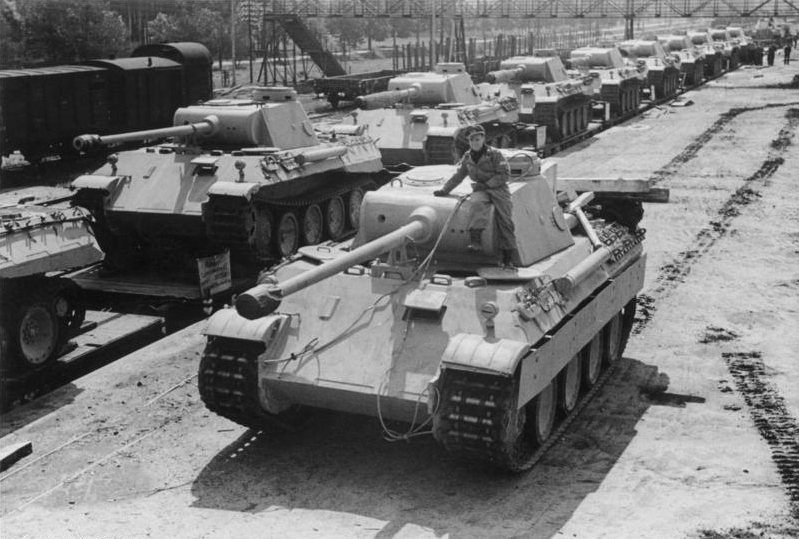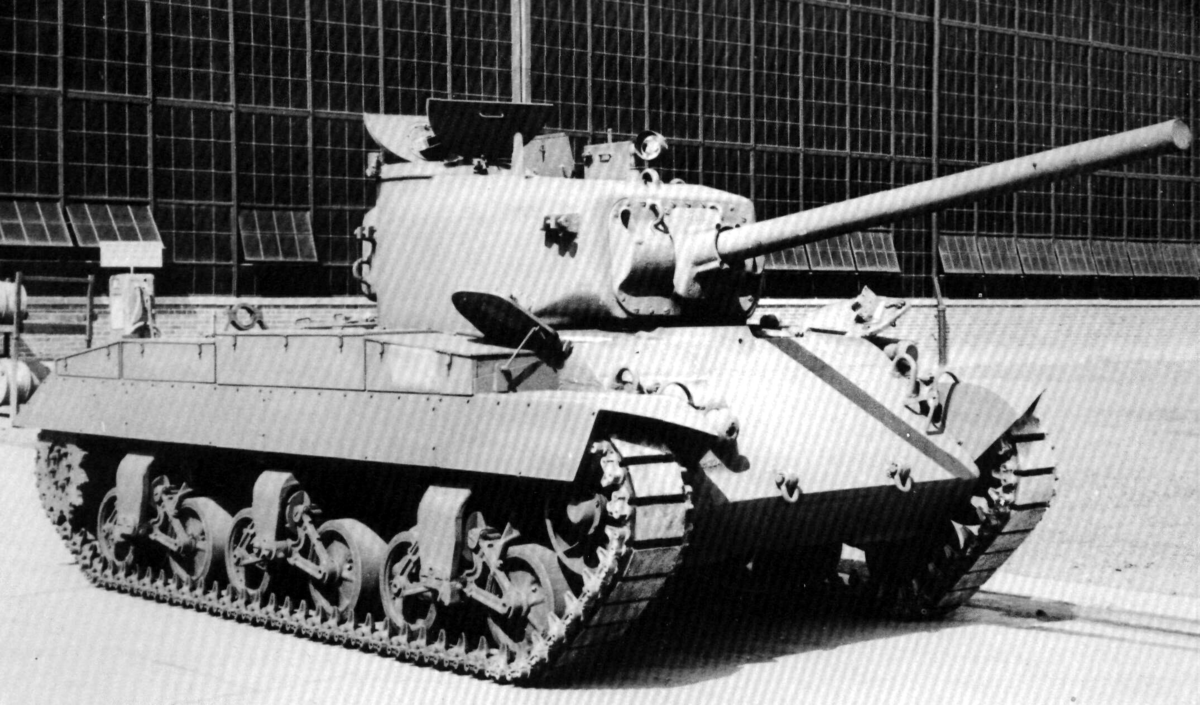That extra 20mm of armor is the difference between a T-34 knocking you out at 1km vs it having to try to close the distance in vain to 100 meters.
Got a source on that? Doesn't seem like it 20mm would make it that much less vulnerable from 1000-100m.
How much lighter and more reliable would the Panther have been without the extra armor? I have no idea, but frankly that protection difference sounds extremely significant, especially considering how much of the Panther's problems were teething issues and the lack of proper maintenance crew for the Germans late in the war. I forget the source and the specifics, but I remember a late '44/early '45 report showing that a higher proportion of Panthers were operational than Panzer IV's at any given time, thus showing that the Panther was more reliable than previously thought.
The lack of 20mm of armor at the front would save at least 1 ton of weight.
20mm wasn't worth all the trouble that came with it. The teething issues came from being overweight and not upgrading the parts to handle said new weight due to the lack of time before rushing it into production. The Panther was supposed to be a 35 ton design originally. The 1943-44 issues weren't truly caused simply by normal teething issues or poor maintenance, it was an overweight design and it took until 1944 to fix the parts being overloaded...at least to a tolerable degree.
I mean the Panthers catching fire coming off the train at Kursk weren't the fault of lack of proper maintenance since they were brand spanking new.

en.wikipedia.org
The first Panthers saw combat at Kursk in summer 1943, revealing reliability issues beyond that typically expected for a new weapon system. This was improved through 1943; the Panther's operational rate went from 16 percent at the end of July 1943 to 37 percent by December 1943.
An improved version, the
Panther Ausf. A, entered production in August 1943. This received improvements from the
Panther Ausf. D, including a better turret with a new commander's cupola and increased turret traverse speed. More improvements began to have an effect on the combat-ready rate of the tanks deployed on the Eastern Front, which increased from 37 percent in February, to 50 percent in April, and 78 percent by the end of May 1944.
[116]
General
Heinz Guderian reported on 5 March 1944:
The frontline reports said service life of the tank's engine had increased up from 700 to 1,000km [435 to 621 miles]. Plus, the same Panther tank-equipped units reported that failures regarding final drive, transmission and steering gears were within a suitable range.
[117]
They eventually became more reliable with later marks, though 'suitable range' of failures in late 1944 is something quite a bit different than in say 1941.
Why wait on the L/70? It would have been interesting to know what the German late war designs would have looked like after successful experiences with rear transmissions with an in-service VK 30.02
Because it was largely unnecessary until late 1944. T-34s, even the /85 was killable with the L/48 75mm at 1000m. Most kills by any 75mm were at ranges within 1000m. The longer gun was really only necessary to try and slug it out at long range with the JS-series and various SP guns the Soviets had, which was still not a great idea. In 1943-most of 1944 the L48 was more than enough to deal with the Soviet's main tank model, while in Western Europe and Italy the long range potential of the L70 was wasted as something like 90% of all kills happened within 800m and again the 75mm L48 could kill an M4 Sherman at 1000m at least. Against Churchill tanks you might need the L70, but those were comparatively rare and could be handled by dedicated TDs.
I'd imagine late war German designs with a rear drive would look like the Leopard 1 with an 88mm gun.
Which German books do you suggest? I recall reading that in late 1941, in anticipation of a successful Barbarossa, Hitler ordered production of AFVs cut in favor of increased air and sea production. Do you know if that’s accurate and what effect it had? In any case, given Tooze's vehemence, I do question if the Germans truly couldn't have found a way to squeeze out more sooner, and what sort of inefficiencies could have been solved early in the war.
Not off hand, but it wouldn't surprise me given that he started forming new Panzer divisions in September instead of reinforcing his units in the East and pulled out the 2nd air fleet in November right as the battle for Moscow was peaking.
Of course Germany could have cut more corners to squeeze out more, but still in terms of AFVs the big increase came with the introduction of the mass production optimized Panther and the completion of more panzer production lines in 1942.

www.globalsecurity.org
BTW the biggest and most modern tank factory, the St. Valentin works in Austria (I have an excellent book about it) only reached full operational status in 1943. It started with very basic production in 1941 after breaking ground in 1938. In fact that is where the Elefant TDs were made.
That link is broken for me, can you please send an Amazon link?
Not sure why it isn't working. Title is this:
Panzerfertigung im Zweiten Weltkrieg
That's pretty convincing, but if we're playing what ifs, why not cancel the Pz III and start with a 30 ton tank? Is the extra 10 tons really enough to need very heavy equipment?
Because German industry had no experience with 20 ton tanks or the set up to make 30 ton tanks, as that required special production equipment rated to do so. Yes 10 tons makes a huge difference. That's by the Pz38t chassis stayed in production for the entire war, the lines couldn't be upgraded without significant expense and interruption of the production lines. Same with the Pz II chassis and it being used for all manner of designs, including the famous Wespe SP artillery.
I'm all for canceling the Pz III in 1938 and focusing on the Pz IV design.
They really should have up-armed the Pz I to a 20mm (some were converted with Oerlikon in the SCW) and converted the Pz IIs to Jagdpanzers or some sort of StuG.
Not sure the Pz I could mechanically speaking have been used thusly. Eventually using them as munitions carriers or SP rocket artillery wouldn't be a bad idea, but honestly they were most useful as they were originally intended: as training vehicles.
The Pz II however I totally agree on. Should have been a StuG (yes I know that's a Pz38t derivative, but it was in the same weight class as the PzII):

en.wikipedia.org
However the Pz II was needed as a chassis for artillery:

en.wikipedia.org
What specs exactly are you referring to which limited the designers? What innovations were being introduced on German tanks either structurally (like pike nose) or internally (like stabilizers) in late 1944/45? The Soviets managed to squeeze extreme protection and heavy armament on the IS-2 mod. 1944 which compared extremely favorable to the Tiger II, and the T-44-100 was probably better than the Panther Ausf. G.
No rear drive, no leaf spring suspension, for a while no sloped armor, etc. until later on.
Newly introduced innovations in 1944-45? Maybe the bellville washer suspension of the E-series. Standardization of parts between designs. The E-10 had a hydraulic suspension to make it a smaller target.
The IS-2 was also severely outclassed by the Tiger II in rate of fire, protection (see the weld and armor quality problems of the JS-2s), mobility, etc. The IS-2 was a turreted heavy StuG, not a tank. It was meant for breakthrough operations, not tank combat. Also the JS-3's pike nose was ultimately pointless, as it was never used in combat and designing it ultimately set the design back far enough that it was never to see combat.
The T-44-100 was never used either (and IIRC the gun was too big for the turret for practical combat use) and swiftly replaced by the T-54. Interesting ideas, but they never went anywhere useful other than provide experience for the T-54 design. In practice it is questionable whether the T-44/100 would have been better than the Panther 2, which would have been its true equivalent/contemporary had the war went on. But again rather irrelevant to a discussion about 1939 designs.
Sloped armor might have its own issues, sure, but by 1941 it was easy for all to see that it was worth it and the only viable path forward.
Sure, but it had to be proven in combat first before everyone recognized that as a fact.
The IS-3 and its derivatives threw the US and UK in such a frenzy until they developed the M103 and Conqueror. The pike nose decreased internal volume and was less effective off-axis, definitely, but I wouldn't say the concept was flawed, rather that dart developed became so advanced it rendered armor pretty much ineffective, hence the Leopard.
In the end all the heavy tank concepts proved to be a fool's errand for everyone. During WW2 those designs were maxing out the potential of the heavy tank concept. As it was they were viable as boutique breakthrough weapons given the weapons mix they were facing, but as you say technology swiftly made them redundant post-war.
I would love to learn more about this.
Not much to say really, the M103 and Conquerer were to counter Soviet heavy tanks, but they also learned from the German heavy designs, since the US never designed anything over 45 tons during WW2.
It was dumped because the Soviets didn't want to dedicate the logistics required to field it during peacetime. If there had been a war going on who knows, maybe it would have seen service? It was fairly fast and reliable for such a large and heavy tank. It was honestly pretty much better in every way than the T-10A.
Why did they continue developing the T10 then? Why did the Soviets consider the T-10 more production worthy?
What do you think was innovative about the E-series tanks (not tank destroyers)? The E-100 had extremely thin turret sides and the E-50/E-75 was essentially the Tiger II with thicker, better angled front armor.
Mentioned above: commonality of parts, cheap/reliable suspension, more powerful guns than any exist AFVs.
I mean you don't need radical new innovations if the existing concepts were enough for the design goals.
 en.wikipedia.org
en.wikipedia.org
 en.wikipedia.org
en.wikipedia.org






